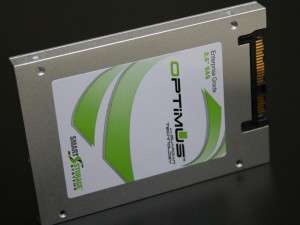 The race to get the performance and longevity of expensive SLC flash at MLC prices has been going on for some time now.
The race to get the performance and longevity of expensive SLC flash at MLC prices has been going on for some time now.
SMART Storage Systems believe that their unique blend of technologies has the potential to replace SLC-based drives in many applications, helping to tip the scales of price vs. performance in favor of high-endurance MLC products.
SMART’s Optimus SAS SSD is designed to accommodate ten full random drive writes per day for five years while achieving high levels of performance along the way. We can test the performance of the Optimus, but verifying SMART’s claims about it’s endurance is impractical. Nevertheless, it has five years of warranty coverage and some impressive characteristics to explore in greater detail.
INTRODUCTION
SMART’s Optimus line is separated into three distinct tiers: The bog-standard Optimus, which supports 10 drive writes per day (DWPD), the Optimus Ultra (25 DWPD), and the Ultra+ (for a whopping 50 DWPD over five years). We’re looking at the standard Optimus today, but they’re all fundamentally the same SAS product on the inside.
Part of SMART’s value equation is using standard consumer flash to get low out-the-door prices. Of course, you need a strategy to extend the useful lifespan of the drive, and SMART attributes their higher endurance characteristics to thorough NAND characterization at the factory in addition to their proprietary flash management techniques. If you can level the playing field between SLC and MLC, you can use the SMART Optimus in workloads you wouldn’t have considered previously.If you can get the speed and endurance you need from a couple MLC-based SAS drives, you can save huge sums of money over SLC offerings which might be overkill or otherwise offer no advantage.
The Optimus we’re examining today is a 400GB model, but it’s available in capacities of 200GB, 800GB, and a rather larger 1.6TB model too. All have similar performance characteristics and longevity ratings. SMART declined to comment on price, but it’s logical to expect pricing of less than half that of SLC based solutions, perhaps 2x or 3x the price per GB of consumer-based offerings.
On the performance front, Optimus brings 500MB/s throughput and 100K/50K random read/write IOPS to the table. SMART doesn’t tell whether those are fresh out of box numbers or at steady state, but we’ll answer that shortly.
INSIDE THE SMART OPTIMUS
The Optimus’ chassis is aluminum, but it feels well built. As it turns out, the chassis is machined to conform to the PCB’s topology, acting like a heatsink to keep the inside at a reasonable operating temperature. It’s well milled, and quite effective in this regard; it does get toasty.
With the exterior out of the way, the PCB is home to a lot of components. The yellow-ish items are a series of tantalum capacitors, part of SMART’s “EverGuard” system. It’s a power-loss-protection system which uses several caps instead of one supercapacitor. Intel’s 320 series uses a similar system, while many SandForce-based drives use supercaps. Supercaps are more expensive, and represent a single point of failure. Power-loss-protection lets the drive finish writes in the event of a power interruption to greatly reduce the chances of data corruption.
SMART has gone with 24nm Toshiba Toggle Mode NAND flash memory for the Optimus. There are a total of 16 NAND packages, each 32GB in capacity for a total of 512GB. The NAND is similar to that you’d find on any manner of Toggle based consumer drives. It’s just regular, garden variety MLC. The high endurance (10 DWPD * 5 years = 18250 total random drive writes) comes from ensuring that the flash is consistently good while intelligently managing the flash.
 The SSD Review The Worlds Dedicated SSD Education and Review Resource |
The SSD Review The Worlds Dedicated SSD Education and Review Resource | 

Firmware ultimately ends up being more important than the controller itself in many or most circumstances. Good FW can make a mediocre drive great, or a great drive a flaming dumpster fire.
That was beautiful, thank you for the insight. 🙂
The SSD market is RED HOT right now! Thanks Les for all the good stuff!
Reliability and predictable performance is very important. I wish consumer-oriented drives would be more like that. As a side note, what’s going on with the 12Gbps connection? Did you manage to sort it out? Perhaps it will work fine with Win7, WIn8 or Server 2012?
this is beautiful.. Wish my old kinston had the speed and reliability of this.